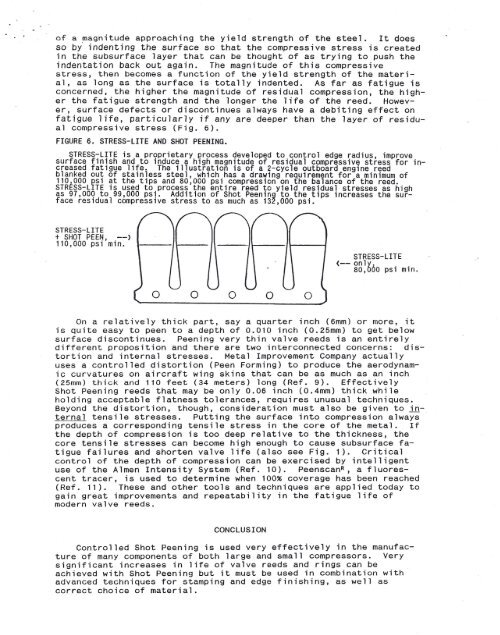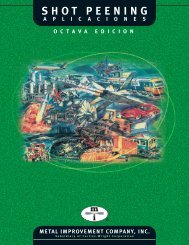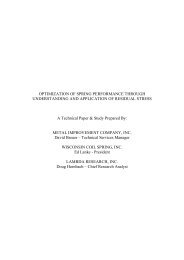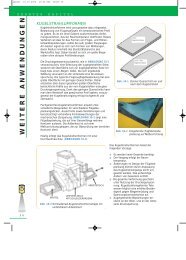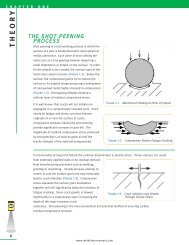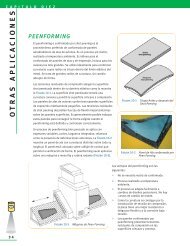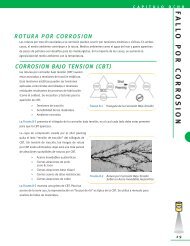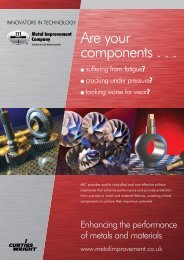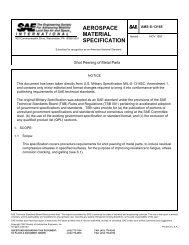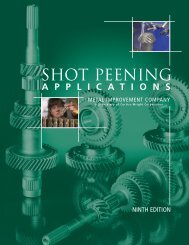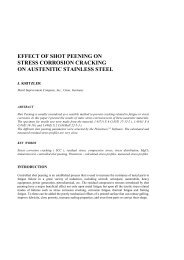Stress-lite Shot Peening of Compressor Reed Valve Components
Stress-lite Shot Peening of Compressor Reed Valve Components
Stress-lite Shot Peening of Compressor Reed Valve Components
You also want an ePaper? Increase the reach of your titles
YUMPU automatically turns print PDFs into web optimized ePapers that Google loves.
<strong>of</strong> a magnitude approaching the yield strength <strong>of</strong> the steel. It does<br />
so by" indenting the surface so that the compressive stress is created<br />
in the subsurface layer that can be thought <strong>of</strong> as trying to push the<br />
indentation back out again. The magnitude <strong>of</strong> this compressive<br />
stress, then becomes a function <strong>of</strong> the yield strength <strong>of</strong> the material,<br />
as long as the surface is totally indented. As far as fatigue is<br />
concerned, the higher the magnitude <strong>of</strong> residual compression, the higher<br />
the fatigue strength and the longer the life <strong>of</strong> the reed. However,<br />
surface defects or discontinues always have a debiting effect on<br />
fatigue life, particularly if any are deeper than the layer <strong>of</strong> residual<br />
compressive stress (Fig. 6).<br />
FIGURE 6. STRESS-LITEAND SHOT PEENING.<br />
STRESS-LITE is a proprietaryprocess developedto control edge radius, improve<br />
surface finish and to induce a high magnitude<strong>of</strong> residual compressivestress for increased<br />
fatigue life. The illustrationis <strong>of</strong> a 2-cycle outboard engine reed<br />
blanked out <strong>of</strong> stainless steel, which has a drawing requirementfor a minimum <strong>of</strong><br />
110 000 psi at the tips and 80,000 psi compressionon the balance <strong>of</strong> the reed.<br />
STR~SS-LITE is used to process the entire reed to yield residual stresses as high<br />
as 97,000 to 99,000 psi. Addition <strong>of</strong> <strong>Shot</strong> <strong>Peening</strong> to the tips increasesthe surface<br />
residual compressivestress to as much as 132,000 psi.<br />
STRESS-LITE<br />
+ SHOT PEEN, --}<br />
110,000 psi min.<br />
o o o o o<br />
STRESS-LITE<br />
(-- only<br />
80,060 psi min.<br />
On a relatively thick part, say a quarter inch (6mm) or more, it<br />
is quite easy to peen to a depth <strong>of</strong> 0.010 inch (0.25mm) to get below<br />
surface discontinues. <strong>Peening</strong> very thin valve reeds is an entirely<br />
different proposition and there are two interconnected concerns: distortion<br />
and internal stresses. Metal Improvement Company actually<br />
uses a controlled distortion (Peen Forming) to produce the aerodynamic<br />
curvatures on aircraft wing skins that can be as much as an inch<br />
(25mm) thick and 110 feet (34 meters) long (Ref. 9). Effectively<br />
<strong>Shot</strong> <strong>Peening</strong> reeds that may be only 0.06 inch (0.4mm) thick while<br />
holding acceptable flatness tolerances, requires unusual techniques.<br />
Beyond the distortion, though, consideration must also be given to internal<br />
tensile stresses. Putting the surface into compression always<br />
produces a corresponding tensile stress in the core <strong>of</strong> the metal. If<br />
the depth <strong>of</strong> compression is too deep relative to the thickness, the<br />
core tensile stresses can become high enough to cause subsurface fatigue<br />
failures and shorten valve life (also see Fig. 1). Critical<br />
control <strong>of</strong> the depth <strong>of</strong> compression can be exercised by intelligent<br />
use <strong>of</strong> the Almen Intensity System (Ref. 10). Peenscan R , a fluorescent<br />
tracer, is used to determine when 100% coverage has been reached<br />
(Ref. 11). These and other tools and techniques are applied today to<br />
gain great improvements and repeatability in the fatigue life <strong>of</strong><br />
modern valve reeds.<br />
CONCLUSION<br />
Controlled <strong>Shot</strong> <strong>Peening</strong> is used very effectively in the manufacture<br />
<strong>of</strong> many components <strong>of</strong> both large and small compressors. Very<br />
significant increases in life <strong>of</strong> valve reeds and rings can be<br />
achieved with <strong>Shot</strong> <strong>Peening</strong> but it must be used in combination with<br />
advanced techniques for stamping and edge finishing, as well as<br />
correct choice <strong>of</strong> material.


